Amazon SageMaker Canvas
Build highly accurate ML models using a visual interface, no code requiredWhat is SageMaker Canvas?
Amazon SageMaker Canvas is a no-code visual interface that empowers you to prepare data, build, and deploy highly accurate ML models, streamlining the end-to-end ML lifecycle in a unified environment. You can prepare and transform data at petabyte-scale through point-and-click interactions and natural language, powered by SageMaker Data Wrangler. You can tap into the power of AutoML and automatically build custom ML models for regression, classification, time series forecasting, natural language processing, and computer vision, supported by SageMaker Autopilot. You can also access, evaluate, fine-tune, and deploy foundation models from Amazon Bedrock and SageMaker JumpStart in a few clicks. Canvas fosters collaboration across teams, provides transparency into the generated code, and ensures governance through model versioning and access controls. With Canvas, you can accelerate innovation and boost productivity by quickly building custom ML models or fine-tuning foundation models to meet your business needs regardless of coding expertise.
Benefits of SageMaker Canvas
Build across the ML lifecycle
Leverage end-to-end machine learning capabilities, including data preparation with Data Wrangler and AutoML model training with Autopilot, all through a visual, no-code interface.

Prepare Your Data with Natural Language and Point-and-Click at Petabyte-Scale
- Access and import data from 50+ sources, including Amazon S3, Athena, Redshift, Snowflake, and Databricks
- Improve data quality and model performance with 300+ pre-built analyses and transformations
- Utilize natural language to analyze and transform your data
- Visually build and refine your data pipelines with an intuitive, low-code / no-code interface
- Scale to petabyte-size data with a few clicks

Train and Evaluate Models Across Multiple Problem Types
- Harness the power of AutoML to automatically explore and optimize models for your specific use case
- Train models for regression, classification, time series forecasting, natural language processing, computer vision, and fine-tune foundation models with just a few clicks
- Tailor your model training with flexible options for objective metrics, data splits, and model controls like algorithm selection and hyperparameters
- Gain insights into model performance with interactive visualizations and model explanations
- Select the best-performing model from a model leaderboard, and export the generated code for further customization

Generate Accurate Predictions at Scale - Batch or Real-Time
- Perform interactive predictions and what-if analyses directly within the application
- Deploy models with a single click to a SageMaker endpoint for real-time inference, or run batch predictions ad-hoc or with automated schedules
- Ensure governance and version control by registering models in the SageMaker Model Registry
- Seamlessly share models with Amazon SageMaker Studio for advanced customization and collaboration
- Visualize and share predictions with stakeholders using Amazon QuickSight for enhanced decision-making
Build with foundation models
- Easily compare and select the most suitable foundation model for your task
- Fine-tune foundation models using your labeled training dataset for business use-cases in a few clicks

Make use of your generative AI
- Query your own documents and knowledge bases stored in Amazon Kendra to generate tailored outputs
- Gain insights into model performance with interactive visualizations, model explanations, and leaderboards
- Productionize and deploy the most suitable foundation models to real-time SageMaker endpoints

Collaborate and ensure governance
Democratize ML while fostering collaboration between teams. Enable model sharing and integration with other AWS services for governance and MLOps.

Foster Cross-Team Collaboration and Knowledge Sharing
- Collaborate with data scientists and experts through easy model sharing with SageMaker Studio
- Use models built by data scientists within Canvas workspace to generate predictions
- Increase trust with code transparency with automatically generated notebooks
- Share models, predictions, and insights with stakeholders via Amazon QuickSight dashboards
- Maintain version control and model lineage tracking, ensuring reproducibility and traceability across teams

Ensure Governance and MLOps Best Practices
- Implement granular user-level permissions and access controls for secure model management
- Enable seamless authentication with single sign-on (SSO) capabilities
- Adhere to model governance and versioning by registering models in the SageMaker Model Registry
- Streamline MLOps pipelines by exporting model notebooks for further customization and integration
- Optimize costs and resource utilization with auto-shutdown features